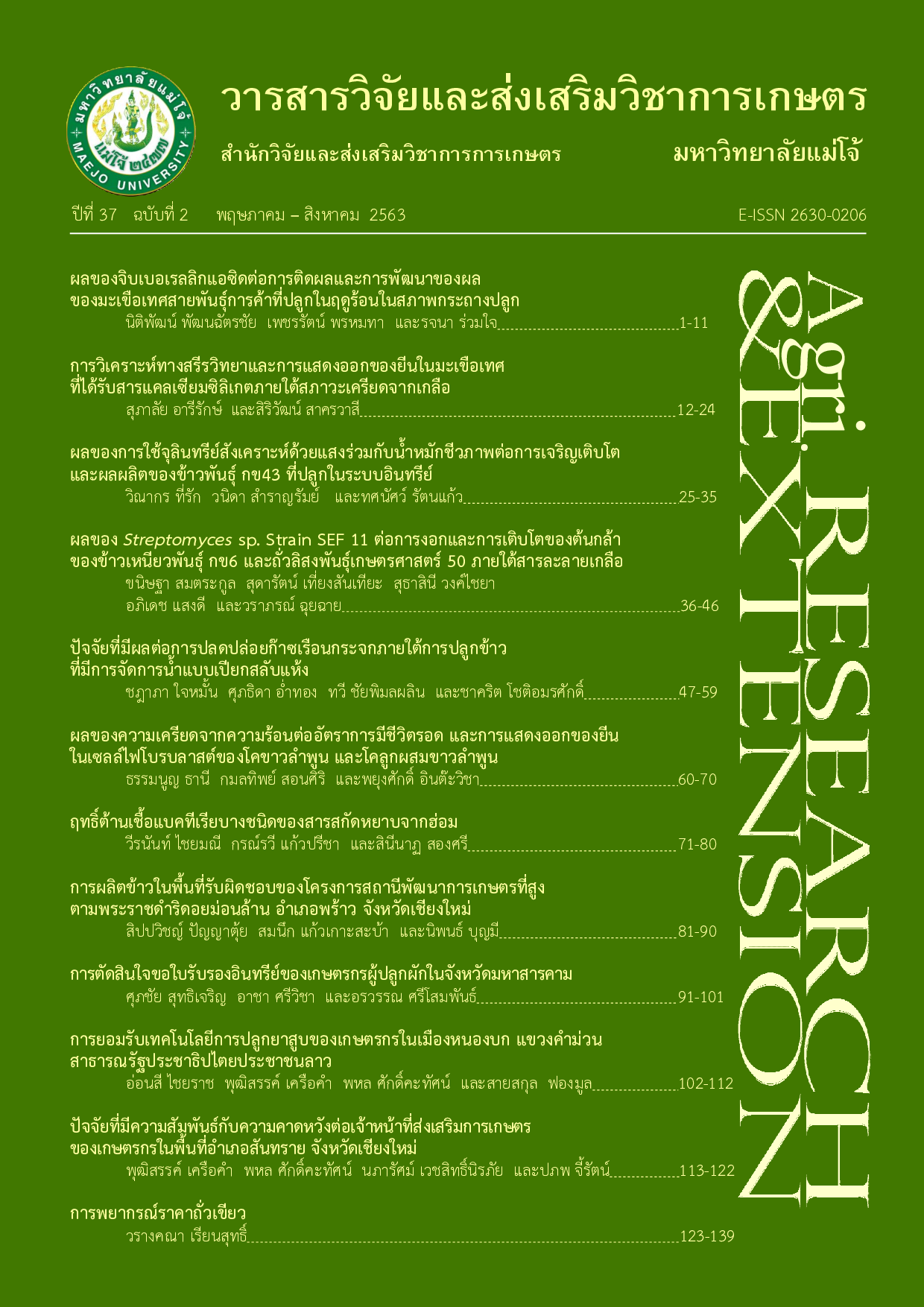ผลของจิบเบอเรลลิกแอซิดต่อการติดผลและการพัฒนาของผลมะเขือเทศสายพันธ์ุการค้าที่ปลูกในฤดูร้อนในสภาพกระถางปลูก
คำสำคัญ:
จิบเบอเรลลิกแอซิด, มะเขือเทศ, การติดผล, การพัฒนาของผล, ฤดูร้อนบทคัดย่อ
บทคัดย่อ
การวิจัยนี้ มีวัตถุประสงค์ เพื่อทราบถึงผลของระดับความเข้มข้นในการฉีดพ่นจิบเบอเรลลิกแอซิด (GA3) แก่มะเขือเทศพันธุ์เรนเจอร์ในแต่ละระยะการบานของดอกที่มีผลต่อการติดผลและการพัฒนาของผล ในฤดูร้อนในสภาพกระถางปลูก วางแผนการทดลองแบบสุ่มสมบูรณ์ที่จัดสิ่งทดลองแบบแฟคทอเรียล จำนวน 2 ปัจจัย ได้แก่ ระยะการฉีดพ่น 3 ระยะ คือ 0 วัน (วันที่ดอกบาน) หลังดอกบาน 2 และ 4 วัน และระดับความเข้มข้น 4 ระดับ คือ 0 50 100 และ 200 มก./ลิตร แต่ละสิ่งทดลองทำ 5 ซ้ำ ในระหว่างเดือนกุมภาพันธ์ ถึง เดือนมิถุนายน 2560 ภายใต้โรงเรือนที่คลุมด้วยตาข่ายไนลอนสีขาว ณ คณะเกษตรและอุตสาหกรรมเกษตร มหาวิทยาลัยราชภัฏสุรินทร์ พบว่า การฉีดพ่น GA3 ในระยะหลังดอกบาน 2 วัน มีจำนวนผลต่อช่อดอกเฉลี่ยสูงที่สุด (1.792 ผล) และที่ระดับความเข้มข้น 200 มก./ลิตร มีผลต่ออัตราส่วนน้ำหนักสดของเนื้อผลต่อผนังผลชั้นในรวมพลาเซนตาและเมล็ดเฉลี่ยสูงที่สุด (2.917) อิทธิพลร่วมของการฉีดพ่น GA3 ในระยะ 0 วัน ด้วยระดับความเข้มข้น 200 มก./ลิตร มีผลต่ออัตราส่วนความยาวต่อความกว้างของผลเฉลี่ยสูงที่สุด (1.352) และมีความหนาของเนื้อผลเฉลี่ยสูงที่สุด (0.682 เซนติเมตร) อย่างไรก็ตามการฉีดพ่น GA3 ในระยะเดียวกันด้วยระดับความเข้มข้น 100 มก./ลิตร มีผลต่อน้ำหนักต่อผลเฉลี่ยสูงที่สุด (52.390 กรัม) แต่ที่ระดับความเข้มข้น 50 มก./ลิตร มีผลต่ออัตราส่วนเมล็ดสมบูรณ์ต่อเมล็ดไม่สมบูรณ์เฉลี่ยสูงที่สุด (3.146) นอกจากนี้แล้ว การฉีดพ่น GA3 ความเข้มข้น 100 มก./ลิตร หลังดอกบาน 4 วัน มีผลต่อน้ำหนักสดของเนื้อผลเฉลี่ยสูงที่สุด (23.808 กรัม) และน้ำหนักผลต่อช่อดอกเฉลี่ยสูงที่สุด (32.644 กรัม) ซึ่งไม่แตกต่างจากการฉีดพ่นด้วยน้ำกลั่นที่ระยะเดียวกัน (32.000 กรัม)
เอกสารอ้างอิง
Abdel-Rahman, M., T.H. Thomas, G.J. Doss and L. Howell. 1975. Changes in endogenous plant hormones in cherry tomato fruit during development and maturation. Physiol. Plantarum. 34(1): 39-43.
Arteca, R.N. 1996. Plant Growth Substances: Principles and Applications. New York: Chapman & Hall. 332 p.
Cutler, H.G. and B.A. Schneider. 1990. Plant Growth Regulator Handbook. 3rd ed. Ithaca, NY: Plant Growth Regulator Society of America. 146 p.
Davies, P.J. 1995. Plant Hormones Physiology, Biochemistry and Molecular Biology. Dordrecht, The Netherlands: Kluwer Academic. 833 p.
de Jong, M., M. Celestina and W.H. Vriezen. 2009. The role of auxin and gibberellin in tomato fruit set. J. Exp. Bot. 60(5): 1523-1532.
Gelmesa, D., B. Abebie and L. Desalegn. 2012. Regulation of tomato (Lycopersicon esculentum Mill.) fruit setting and earliness by gibberellic acid and 2,4-dichlorophenoxy acetic acid application. African J. Biot. 11(51): 11200-11206.
Gillaspy, G., H. Ben-David and W. Gruissem. 1993. Fruits: a developmental perspective. The Plant Cell 5(10): 1439-1451.
Kasetsart University. 2016. Tomato Growing. [Online]. Available http://www.ku.ac.th/e-magazine/nov49/agri/lycopersicon.htm (13 December 2016). [in Thai]
Kazemi, M. 2014. Effect of gibberellic acid and potassium nitrate spray on vegetative growth and reproductive characteristics of tomato. J. Biol. Environ. Sci. 8(22): 1-9.
Khan, J.M., A.C. Gautam, F. Mohammad, M.H. Siddigui, M. Naeem and M.N. Khan. 2006. Effect of gibberellic acid spray on performance of tomato. Turk. J. Biol. 30: 11-16.
Koshioka, M., T. Nishijima, H. Yamazaki, Y. Liu, M. Nonaka and L.N. Mander. 1994. Analysis of gibberellins in growing fruits of Lycopersicon esculentum after pollination or treatment with 4-chlorophenoxyacetic acid. J. Hortic. Sci. 69(1): 171-179.
Kumar, A., T.K. Biswas, N. Singh and E.P Lal. 2014. Effect of gibberellic acid on growth, quality and yield of tomato (Lycopersicon esculentum Mill.). J. Agric. Vet. Sci. 7(7): 28-30.
Kuo, C.G., B.W. Chen, M.H. Chov, C.L. and J.S. Tsay. 1978. Tomato Fruit Set at High Temperature. pp. 94-108. In Proceedings of the 1st International Symposium on Tropical Tomato. Shanhua: Asian Vegetable Research and Development Center.
Mapelli, S., C. Frova, G. Torti and G.P. Soressi. 1978. Relationship between set, development and activities of growth regulators in tomato fruits. Plant and Cell Physiol. 19(7): 1281-1288.
Moore, R., W.D. Clark, K.R. Stern and D. Vodopich. 1995. Botany. Dubugue, IA: Wm. C. Brown Communications. 824 p.
Naeem, N., M. Ishtiaq, P. Khan, N. Mohammad, J. Khan and B. Jamiher. 2001. Effect of gibberellic acid on growth and yield of tomato cv. Roma. J. Biol. Sci. 1(6): 448-450.
Nester, J.E. and J.A.D. Zeevaart. 1988. Flower development in normal tomato and gibberellin deficient (ga-2) mutant. Am. J. Bot. 75(1): 45-55.
Sasaki, H., T. Yano and A. Yamasaki. 2005. Reduction of high temperature inhibition in tomato fruit set by plant growth regulators. JARQ. 39(2): 135-138.
Serrani, J.C., R. Sanjuán, O. Ruiz-Rivero, M. Fos and J.L. Garcia-Martinez. 2007. Gibberellin regulation of fruit set and growth in tomato. Plant Physiol. 145(1): 246-257.
Sritathanee, K. 1997. Cherry Tomato. Advanced Agriculture 12(2): 61-62.
Srivastava, L.M. 2002. Plant Growth and Development: Hormones and Environment. Amsterdam: Academic. 772 p.
ดาวน์โหลด
เผยแพร่แล้ว
รูปแบบการอ้างอิง
ฉบับ
ประเภทบทความ
สัญญาอนุญาต
ลิขสิทธิ์ (c) 2020 วารสารวิจัยและส่งเสริมวิชาการเกษตร

อนุญาตภายใต้เงื่อนไข Creative Commons Attribution-NonCommercial-NoDerivatives 4.0 International License.
บทความนี้ได้รับการเผยแพร่ภายใต้สัญญาอนุญาต Creative Commons Attribution-NonCommercial-NoDerivatives 4.0 International (CC BY-NC-ND 4.0) ซึ่งอนุญาตให้ผู้อื่นสามารถแชร์บทความได้โดยให้เครดิตผู้เขียนและห้ามนำไปใช้เพื่อการค้าหรือดัดแปลง หากต้องการใช้งานซ้ำในลักษณะอื่น ๆ หรือการเผยแพร่ซ้ำ จำเป็นต้องได้รับอนุญาตจากวารสาร





